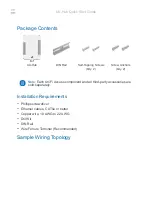
9 of 12
Before adjusting the dial settings, read through the sequence of operation to ensure that you understand how the control operates.
STEP FOUR
Mixing Starting Temperature (MIX Start)
The MIX Start setting is the starting supply water temperature of the reset ratio, and can be adjusted from 35 to 150
°
F (2 to 66
°
C).
This setting is typically set to the desired building temperature. In applications where fan coils are used, the MIX Start may need to
be set higher to prevent cold drafts during mild outdoor conditions. If the building feels cool during mild outdoor conditions, the MIX
Start setting should be increased.
Outdoor Starting Temperature (OUTDR Start)
The OUTDR Start setting is the outdoor temperature at which the mixing starting temperature is supplied. The adjustment range is
from 35 to 85
°
F (2 to 29
°
C). This setting is typically set to the desired building temperature.
Mixing Design Temperature (MIX DSGN)
The MIX DSGN setting is the water temperature required to satisfy the building heat loss during the coldest outdoor temperature. This
adjustment is typically dependent on the type of heating terminal used. The following are suggested settings for different terminal units:
• Inslab Radiant ..................... 100 to 140
°
F (38 to 60
°
C)
• Radiant Baseboard ................. 130 to 160
°
F (54 to 71
°
C)
• Staple-up Radiant
.......... 130 to 160
°
F (54 to 71
°
C)
• Convective Baseboard
....... 160 to 190
°
F (71 to 88
°
C)
• Radiators ............................ 140 to 160
°
F (60 to 71
°
C)
• Fan Coil
.............................. 180
to 200
°
F (82 to 93
°
C)
Outdoor Design Temperature (OUTDR DSGN)
The OUTDR DSGN setting is the outdoor temperature used in the heat loss calculation. It is set to the typical coldest outdoor
temperature.
Mixing Maximum Temperature (MIX MAX)
The PC705-2 prevents the mixed supply water temperature from rising above the MIX MAX setting. The adjustment range is from
80 to 225
°
F (27 to 107
°
C). The MIX MAX should be set to the maximum temperature allowed in the system loop. There are many
factors which may limit the allowable supply water temperature in a radiant floor heating slab; a few are provided below.
• Nowhere in the concrete should the temperature be maintained above 170
°
F (77
°
C).
• The surface temperature of a radiant floor heating slab should normally not exceed 85
°
F (29
°
C). The slab surface temperature is
affected by the slab thermal resistance, the heating load, and the supply water temperature to the slab.
Boiler Minimum Supply Temperature (BOIL MIN)
Most boilers require a minimum operating temperature to prevent corrosion from flue gas condensation. The minimum boiler setting
should be programmed to the lowest supply water temperature at which the boiler can operate without causing the boiler flue gases
to condense. Consult the boiler manufacturer for recommended minimum boiler supply temperatures. Some typical settings are as
follows:
• Steel fire tube boiler ….......... 140 to 160
°
F (60 to 71
°
C)
• Condensing boiler ................. Off
• Cast iron boiler ….................. 135 to 160
°
F (57 to 71
°
C)
• Electric boiler ........................ Off
• Copper tube boiler …............. 125 to 150
°
F (52 to 66
°
C)
Note: This setting is only available if a boiler sensor is connected to the PC705-2.
Warm Weather Shut Down (WWSD)
The WWSD can be adjusted from 35 to 100
°
F (2 to 38
°
C). The system will be shut down when the outdoor temperature is warmer
than this setting.
Settings
Control Adjustments
Mixing Start:
Outdoor Start:
Mixing Design:
Outdoor Design:
Mixing Maximum:
Boiler Minimum:
WWSD:
System Pump
The PC705-2 has an internal relay rated for 5 Amps to operate a system pump. Connect the black wire from the back of the control
to the live (L) side of the 120 V (ac) power source. Connect one of the wires from the system pump to the red wire from the back
of the control. The other wire on the system pump must be connected to the neutral (N) side of the 120 V (ac) power supply. Connect
the green wire on the back of the control to ground.






























